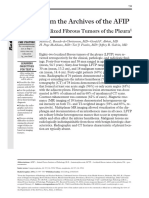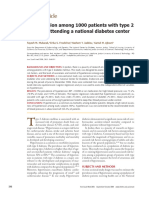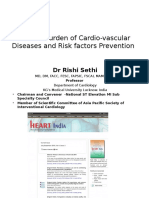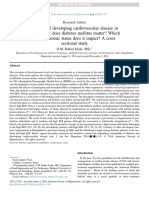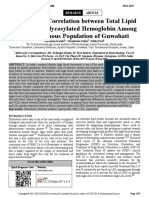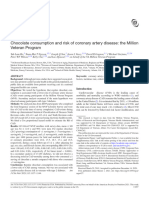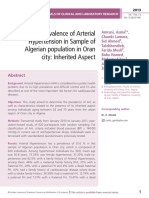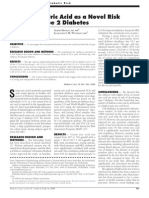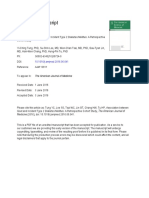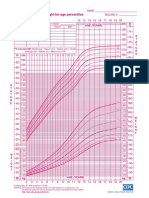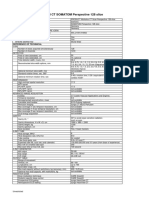Dme 12392
Dme 12392
Uploaded by
Anastasia FebriantiCopyright:
Available Formats
Dme 12392
Dme 12392
Uploaded by
Anastasia FebriantiOriginal Description:
Original Title
Copyright
Available Formats
Share this document
Did you find this document useful?
Is this content inappropriate?
Copyright:
Available Formats
Dme 12392
Dme 12392
Uploaded by
Anastasia FebriantiCopyright:
Available Formats
Research: Epidemiology
Associations of blood glucose and prevalent diabetes
with risk of cardiovascular disease in 500 000 adult
Chinese: the China Kadoorie Biobank
F. Bragg
1
, L. Li
2
, M. Smith
1
, Y. Guo
3
, Y. Chen
1
, I. Millwood
1
, Z. Bian
3
, R. Walters
1
, J. Chen
4
,
L. Yang
1
, R. Collins
1
, R. Peto
1
, Y. Lu
5
, B. Yu
6
, X. Xie
7
, Y. Lei
8
, G. Luo
9
and Z. Chen
1
on behalf
of the China Kadoorie Biobank Collaborative Group
1
Clinical Trial Service Unit and Epidemiological Studies Unit (CTSU), Nufeld, Department of Population Health, University of Oxford, UK,
2
Department of Public
Health, Beijing University, Beijing,
3
Chinese Academy of Medical Sciences, Beijing,
4
China National Center for Food Safety Risk Assessment, Beijing,
5
Suzhou
Centre for Disease Control and Prevention, Suzhou,
6
Nangang Centre for Disease Control and Prevention, Harbin,
7
Liuyang Centre for Disease Control and
Prevention, Liuyang,
8
Maiji Centre for Disease Control and Prevention, Tianshui and
9
Pengzhou Centre for Disease Control and Prevention, Pengzhou, China
Accepted 12 December 2013
Abstract
Aims To examine the relationship of self-reported diabetes, and of random blood glucose levels among individuals
without known diabetes, with the prevalence of cardiovascular disease in Chinese adults.
Methods We examined cross-sectional data from the China Kadoorie Biobank of 0.5 million people aged 3079 years
recruited from 10 diverse regions of China in the period 20042008. Logistic regression was used to estimate the odds
ratios of prevalent cardiovascular disease associated with self-reported diabetes, and with measured random blood
glucose levels among participants with no history of diabetes, adjusting simultaneously for age, sex, area, education,
smoking, alcohol, blood pressure and physical activity.
Results A total of 3.2% of participants had self-reported diabetes (men 2.9%; women 3.3%) and 2.8% had
screen-detected diabetes (men 2.6%; women 2.8%), i.e. they had no self-reported history of diabetes but a blood glucose
level suggestive of a diagnosis of diabetes. Compared with individuals without a history of diabetes, the odds ratios
associated with self-reported diabetes were 2.18 (95% CI 2.062.30) and 1.88 (95% CI 1.752.01) for prevalent
ischaemic heart disease and stroke/transient ischaemic attack, respectively. Among participants without self-reported
diabetes there was a positive association between random blood glucose and ischaemic heart disease and stroke/transient
ischaemic attack prevalence (P for trend <0.0001). Below the diabetic threshold (<11.1 mmol/l) each additional 1 mmol/
l of random blood glucose was associated with 4% (95% CI 25%) and 5% (95% CI 37%) higher odds of prevalent
ischaemic heart disease and stroke/transient ischaemic attack, respectively.
Conclusions In this adult Chinese population, self-reported diabetes was associated with a doubling of the odds of
prevalent cardiovascular disease. Below the threshold for diabetes there was still a modest, positive association between
random blood glucose and prevalent cardiovascular disease.
Diabet. Med. 31, 540551 (2014)
Introduction
Cardiovascular disease is the leading cause of morbidity and
mortality worldwide [1]. Diabetes is an important risk
factor for cardiovascular disease; patients with diabetes
experience at least a doubling in risk of ischaemic heart
disease and stroke compared with those without diabetes
[2]. There is also evidence to suggest that higher blood
glucose levels below the threshold for diabetes may increase
the risk of cardiovascular disease [2]. In China, the
incidence of diabetes has risen rapidly over recent decades
[3], but there is limited evidence for the association of
diabetes with cardiovascular disease [4,5], which, in con-
trast to most Western populations, is characterized in the
Chinese population by higher rates of stroke and lower rates
Correspondence to: Zhengming Chen. E-mail: zhengming.chen@ctsu.ox.ac.
uk or Liming Li. E-mail: lmlee@vip.163.com
This is an open access article under the terms of the Creative Commons
Attribution License, which permits use, distribution and reproduction in any
medium, provided the original work is properly cited.
540
2013 The Authors.
Diabetic Medicine published by John Wiley & Sons Ltd on behalf of Diabetes UK.
DIABETICMedicine
DOI: 10.1111/dme.12392
of ischaemic heart disease [6]. Moreover, uncertainty
remains about the association of blood glucose with the
risk of cardiovascular disease among the Chinese population
without diabetes [7].
To help address these issues, we report cross-sectional data
from the China Kadoorie Biobank of 0.5 million people [8].
The objectives were to examine: 1) the relationship between
self-reported, doctor-diagnosed diabetes and the prevalence
of cardiovascular disease; 2) the relevance of age, sex, area,
education, smoking status, alcohol consumption, blood
pressure, physical activity and adiposity to observed associ-
ations; and 3) the association between random blood glucose
levels and the prevalence of cardiovascular disease among
people without prior diabetes.
Patients and methods
Study population
The study design and characteristics of the China Kadoorie
Biobank population have been described previously [8,9].
A total of 512 891 men and women aged 3079 years
were recruited between 2004 and 2008 from ve urban
and ve rural areas in China (Fig. 1). The areas were
chosen according to local disease patterns, exposure to
certain risk factors, population stability, levels of economic
development, death and disease registry quality and
practical considerations, including local capacity and com-
mitment. In each area, permanent residents of 100150
administrative units (rural villages or urban residential
committees) were identied through ofcial residential
records, then invited to participate by letter after extensive
publicity campaigns. The population response rate was
~30%.
FIGURE 1 Locations of the China Kadoorie Biobank recruitment centres. Black circles represent urban areas, white circles represent rural areas.
Whats new?
Little is known about the role of diabetes as a risk
factor for cardiovascular disease in the Chinese popu-
lation. Below the threshold for diabetes, substantial
uncertainty exists about the association of blood
glucose levels with cardiovascular disease in Chinese
populations and more generally.
Data from the China Kadoorie Biobank of 0.5 million
middle-aged Chinese adults demonstrated a doubling of
the odds of prevalent ischaemic heart disease and
stroke/transient ischaemic attack among people with
self-reported diabetes. Among people without prior
diabetes, blood glucose levels were positively associated
with prevalent cardiovascular disease.
A comprehensive understanding of the role of both
blood glucose levels and diabetes in cardiovascular
disease risk is fundamental to effective disease preven-
tion and control.
2013 The Authors.
Diabetic Medicine published by John Wiley & Sons Ltd on behalf of Diabetes UK. 541
Research article DIABETICMedicine
Data collection
Data were obtained from participants through inter-
viewer-administered electronic questionnaires, collating
information on demographic and socio-economic character-
istics, lifestyle, personal and family medical history (includ-
ing a history of doctor-diagnosed diabetes, ischaemic heart
disease including myocardial infarction and angina and
stroke/transient ischaemic attack) and current medication
amongst those reporting ischaemic heart disease, stroke/
transient ischaemic attack, hypertension or diabetes. A range
of physical measurements were undertaken by trained
technicians, including height, weight, hip and waist circum-
ference, bio-impedance and blood pressure, using calibrated
instruments with standard protocols.
A 10-ml non-fasting (except in one study area where
participants were asked to fast) blood sample was collected
from participants into an ethylenediamine tetra-acetic acid
vacutainer (BD Hemogard
TM
, BD, Franklin Lakes, NJ,
USA), with the time since the participant last ate recorded.
On-site testing of plasma glucose level was undertaken using
the SureStep Plus meter (LifeScan, Milpitas, CA, USA).
Participants with glucose levels 7.8 mmol/l and
<11.1 mmol/l were invited to return for a fasting blood
glucose test the next day. Random blood glucose data were
unavailable for 8160 participants without self-reported
diabetes (because of a delay in making the on-site test
available in certain regions). Screen-detected diabetes was
dened as no self-reported diabetes with a blood glucose
level 7.0 mmol/l and a fasting time >8 h, a blood glucose
level 11.1 mmol/l and a fasting time <8 h, or a fasting
blood glucose level 7.0 mmol/l.
Ethical approval for the study was obtained from Oxford
University, the China National Centre for Disease Control
and Prevention and the 10 study areas local Centres for
Disease Control and Prevention. All participants provided
informed, written consent.
Statistical analyses
Sex-specic, age- and study area-adjusted random blood
glucose levels in the population without self-reported diabetes
were compared across categories of other variables using
general linear models. Prevalence of self-reported and screen-
detected diabetes were compared across levels of other
variables, standardized to 5-year age groups and study area.
The associations of self-reported and screen-detected
diabetes, and of random blood glucose level amongst people
without self-reported diabetes, with the prevalence of
ischaemic heart disease and stroke/transient ischaemic attack
were examined using multivariate logistic regression. Ran-
dom blood glucose was categorized into six groups (thresh-
olds: 4.8, 5.8, 6.8, 7.8 and 11.1 mmol/l), selected to include
the oral glucose tolerance test 2-h post glucose-load thresh-
olds for impaired glucose tolerance and diabetes [10]. Odds
ratios for cardiovascular disease were calculated, adjusting
simultaneously for age, study area, education (no formal
schooling, primary school, middle school, high school,
college/university), smoking (never, occasional, ex-regular,
current regular), and alcohol (never regular, occasional
intake, ex-regular, reduced intake, weekly intake). In sepa-
rate models, additional adjustments were made for systolic
blood pressure (thresholds: 100, 110, 120, 130, 140, 150,
160 and 170 mmHg) and physical activity (thresholds: 10,
20, 30, 40 metabolic equivalent of task h/day), and for
waisthip ratio (thresholds: 0.75, 0.80, 0.85, 0.90 and 0.95).
For random blood glucose analyses, the oating absolute
risk method was used to provide estimates of variance across
all exposure categories [11]. Chi-squared tests for trend in log
odds ratios were conducted and the estimated odds ratios of
prevalent ischaemic heart disease and stroke/transient ischae-
mic attack were examined for departure from linearity by
testing the type 3 chi-square for categorical random blood
glucose, in a model that contained random blood glucose as a
categorical and a continuous variable. The odds ratios for
each additional 1 mmol/l of random blood glucose were
estimated in participants with a random blood glucose level
<11.1 mmol/l. In participants with neither self-reported nor
screen-detected diabetes, randomblood glucose analyses were
repeated, stratied by fasting time (<8 vs 8 h). The 8-h
threshold was based on fasting duration guidance [12] and
evidence of a threshold in the relationship between random
blood glucose and fasting time at 8 h in the China Kadoorie
Biobank. Adjusted odds ratios associated with self-reported
diabetes were compared across strata of sex, age, rural/urban,
education, smoking status, alcohol consumption, systolic
blood pressure, physical activity, adiposity and treatment
status (which was additionally adjusted for duration of
diabetes diagnosis); chi-squared tests for trend and heteroge-
neity were applied to the estimates for each variable [13].
Statistical analyses were conducted using SAS version 9.3
(SAS Institute Inc., Cary, North Carolina, USA).
Results
Overall, 2.9% of men and 3.3% of women reported a history
of doctor-diagnosed diabetes and a further 2.6% of men and
2.8% of women had screen-detected diabetes. Total diabetes
prevalence (combined self-reported and screen-detected
diabetes) increased with age, and was higher in urban than
in rural areas (Table 1). Ex-regular smokers and drinkers
had the highest self-reported diabetes prevalence compared
with other smoking or alcohol categories (Table 1). Screen-
detected diabetes prevalence was highest amongst ex-regular
smokers, but not ex-regular drinkers. There was a strong
inverse association between physical activity and diabetes
prevalence. Participants with a family history of diabetes
were four times as likely to have doctor-diagnosed diabetes
and approximately twice as likely to have screen-detected
diabetes as those without such a family history (Table 1).
542
2013 The Authors.
Diabetic Medicine published by John Wiley & Sons Ltd on behalf of Diabetes UK.
DIABETICMedicine Blood glucose, diabetes and risk of cardiovascular disease in China F. Bragg et al.
Diabetes prevalence was strongly positively associated with
systolic blood pressure and adiposity (Table 2).
Mean (SE) age- and area-adjusted random blood glucose
was 5.8 (<0.1) mmol/l in men and 6.0 (<0.1) mmol/l in
women without self-reported diabetes. Random blood glu-
cose varied little by socio-economic or lifestyle factors, but
increased with increasing age (Table 1), systolic blood
pressure and adiposity (Table 2).
A total of 2.7% of men and 3.2% of women reported a
history of doctor-diagnosed ischaemic heart disease, higher
than for stroke/transient ischaemic attack (men 2.3%; women
1.3%). The prevalence of ischaemic heart disease and of
stroke/transient ischaemic attack increased with increasing
age, and were higher in urban than in rural areas (ischaemic
heart disease: 4.6 vs 1.7%; stroke/transient ischaemic attack:
2.3 vs 1.3%). After adjusting for age, area, education,
Table 1 Demographic and lifestyle characteristics of China Kadoorie Biobank participants by sex
Characteristic
Men (n = 210 222) Women (n = 302 669)
n
Diabetes (%)*
No
self-reported
diabetes
n
Diabetes (%)*
No self-reported
diabetes
Self-
reported
Screen-
detected
Mean random
blood glucose
,
(mmol/l)
Self-
reported
Screen-
detected
Mean random
blood glucose
,
(mmol/l)
Age
(years)
3039 29594 0.7 1.1 5.3 48210 0.3 0.8 5.5
4049 59230 1.7 2.1 5.6 93519 1.2 1.9 5.8
5059 63715 3.3 3.0 5.9 93841 3.9 3.5 6.1
6069 41331 4.9 3.5 6.1 50440 7.2 4.7 6.4
7079 16352 5.3 4.0 6.2 16659 7.1 4.8 6.4
Rural/urban
Rural 118883 1.6 1.8 5.6 167822 2.4 2.5 5.9
Urban 91339 4.6 3.7 6.0 134847 4.3 3.2 6.0
Highest level of education
No formal schooling 18660 2.8 4.1 5.8 76561 3.4 3.8 6.0
Primary school 70110 2.7 2.9 5.8 95106 3.6 3.2 6.0
Middle school 68172 3.3 2.8 5.8 76741 4.0 2.8 5.9
High school 36727 3.5 2.9 5.8 40800 4.0 2.4 5.8
College or university 16553 4.1 2.7 5.7 13461 3.8 2.0 5.8
Annual household income (Yuan/year)
<2500 6154 2.4 3.7 5.8 9392 2.9 3.9 5.9
25004999 13300 2.8 3.1 5.8 21357 3.1 3.0 6.0
50009999 35283 2.8 2.3 5.8 59346 3.5 2.7 6.0
10 00019 999 59558 2.9 2.6 5.8 89455 3.3 3.0 6.0
20 00034 999 53400 3.1 2.7 5.8 73321 3.4 2.8 6.0
35 000 42527 3.8 3.4 5.8 49798 4.1 2.7 6.0
Smoking
Never 30281 3.2 2.6 5.8 287333 3.3 2.8 6.0
Occasional 23628 3.0 2.5 5.8 5531 3.9 3.2 6.0
Ex-regular 27918 4.1 2.9 5.9 2645 4.9 5.8 6.0
Current regular 128395 2.4 2.6 5.8 7160 4.0 4.3 5.9
Alcohol
Never regular 42764 3.8 2.8 5.8 192435 4.0 3.0 6.0
Occasional 79260 2.7 2.3 5.8 101328 2.4 2.6 5.9
Ex-regular 7923 7.0 2.6 5.9 1333 8.0 3.3 5.9
Reduced intake 10371 5.5 2.6 5.8 1325 3.4 2.8 6.0
Weekly 69904 1.9 2.8 5.8 6248 1.2 2.2 5.9
Physical activity (metabolic equivalent of task h/day)
<10 23487 4.3 3.7 5.9 15293 5.4 3.7 6.0
10-19.9 61366 3.7 2.8 5.8 118436 3.9 3.0 6.0
20-29.9 46417 2.8 2.5 5.8 81247 2.9 2.7 5.9
30-39.9 36948 1.8 2.5 5.8 45148 2.3 2.6 5.9
40 42004 1.5 2.4 5.8 42545 1.5 2.1 5.9
Family history of diabetes
,
**
No 182986 2.4 2.5 5.8 268510 2.7 2.7 5.9
Yes 14225 10.7 4.7 6.1 22347 11.5 4.7 6.2
Fasting time (h)
<8 168500 2.7 2.4 5.9 233913 2.9 2.4 6.1
8 41722 5.1 3.9 5.3 68756 6.2 4.1 5.5
*Standardized to the age and study area structure of the study population;
adjusted for age and study area;
all SE values 0.1;
adjusted for/
standardized to study area only;
rst-degree relatives; **data missing for 24 823 participants.
2013 The Authors.
Diabetic Medicine published by John Wiley & Sons Ltd on behalf of Diabetes UK. 543
Research article DIABETICMedicine
smoking, alcohol, systolic blood pressure and physical activ-
ity, individuals with self-reported diabetes were more than
twice as likely to have ischaemic heart disease (men: odds ratio
2.15, 95% CI 1.962.36; women: odds ratio 2.19, 95% CI
2.052.34) than those without (Table 3). Similar ndings
were observed for stroke/transient ischaemic attack, with a
somewhat greater odds ratio in women (odds ratio 2.08, 95%
CI 1.892.29) than in men [odds ratio 1.64, 95% CI 1.48
1.82 (P for interaction=0.0006)]. Adjusted odds ratios for
prevalent ischaemic heart disease (IHD) with self-reported
diabetes were similar across the strata of other risk factors
with the exception of age and BMI, with a higher odds in
participants aged 3059 years (P = 0.001 for trend), and
increasing odds with increasing BMI [P < 0.001 for trend
(Fig. 2)]. The odds ratios for prevalent stroke/transient
ischaemic attack increased with increasing physical activity
levels (P = 0.02 for trend) but varied little by other risk factors
(Fig. 3). Further adjustment for waisthip ratio moderately
attenuated both associations.
Of the 13 678 (84.6%) participants with self-reported
diabetes with data available on hypoglycaemic medication
use, 76.9% reported taking such medication (84.7% oral
hypoglycaemics; 18.9% insulin). The odds ratio for ischae-
mic heart disease, after adjustment for other cardiovascular
disease risk factors, was signicantly higher in participants
reporting hypoglycaemic medication use than in those not
using such medication (odds ratio 2.25 vs 1.69; P for
heterogeneity <0.001; Fig. S1). This difference was minimally
Table 2 Characteristics of China Kadoorie Biobank participants from physical examination by sex
Characteristic
Men: n = 210 222 Women: n = 302 669
n
Diabetes (%)*
No self-reported
diabetes
n
Diabetes (%)*
No
self-reported
diabetes
Self-
reported
Screen-
detected
Mean random
blood glucose
,
(mmol/l)
Self-
reported
Screen-
detected
Mean random
blood
glucose
,
(mmol/l)
Systolic blood pressure
<100 mmHg 3940 2.0 1.1 5.5 13595 1.3 1.2 5.7
100119 mmHg 50915 2.0 1.5 5.6 94810 2.0 1.6 5.8
120139 mmHg 90876 2.8 2.4 5.8 110743 3.0 2.7 6.0
140159 mmHg 43526 3.5 3.7 6.0 53187 4.6 4.1 6.2
160 mmHg 20965 4.1 4.8 6.1 30334 5.5 5.3 6.2
BMI
<18.5 kg/m
2
9426 1.8 1.7 5.7 12947 1.7 1.7 5.7
18.5 to <22.5 kg/m
2
77017 2.0 1.7 5.6 99120 2.7 1.7 5.8
22.5 to <25 kg/m
2
58581 3.1 2.5 5.8 86868 3.4 2.6 5.9
25 to <30 kg/m
2
58975 3.9 3.8 6.0 88990 3.9 3.9 6.1
30 kg/m
2
6222 5.5 6.4 6.4 14743 4.9 5.9 6.5
Waist circumference
<70 cm 21361 1.2 1.3 5.6 50518 1.4 1.2 5.7
7079.9 cm 70042 1.8 1.5 5.6 117308 2.6 1.9 5.8
8089.9 cm 72494 3.2 2.6 5.8 94766 3.8 3.4 6.1
9099.9 cm 38021 4.3 4.3 6.1 33317 5.0 5.3 6.4
100 cm 8304 5.9 7.0 6.5 6760 7.0 7.8 6.8
Hip circumference
<84 cm 33453 1.9 2.2 5.7 40403 2.7 2.2 5.8
8487.9 cm 41832 2.3 1.9 5.7 58436 3.5 2.5 5.9
8891.9 cm 48447 2.9 2.4 5.8 73849 3.4 2.6 5.9
9295.9 cm 40464 3.4 2.9 5.8 61553 3.4 3.0 6.0
96 cm 46026 3.8 3.9 6.0 68428 3.6 3.8 6.1
Waisthip ratio
<0.75 987 1.1 1.8 5.5 9793 1.0 1.0 5.5
0.750.80 8073 1.1 1.2 5.5 36890 1.2 1.1 5.6
0.800.85 29810 1.2 1.2 5.5 72148 1.9 1.6 5.8
0.850.90 55847 2.1 1.7 5.6 83560 3.0 2.5 5.9
0.900.95 60599 3.0 2.5 5.8 60535 4.3 3.9 6.2
0.95 54906 4.8 4.6 6.2 39743 6.5 6.4 6.6
Percentage body fat
<15 27510 2.1 1.4 5.7 1125 2.0 2.1 5.9
1524.9 117804 2.8 2.0 5.7 45652 2.3 1.4 5.8
2534.9 59762 3.7 4.1 6.0 157011 3.3 2.3 5.9
35 5022 4.1 6.9 6.3 98764 3.8 4.3 6.1
*Standardized to the age and study area structure of the study population;
adjusted for age and study area;
all SE values 0.1;
data missing
for two participants;
data missing for 241 participants.
544
2013 The Authors.
Diabetic Medicine published by John Wiley & Sons Ltd on behalf of Diabetes UK.
DIABETICMedicine Blood glucose, diabetes and risk of cardiovascular disease in China F. Bragg et al.
attenuated after adjustment for duration of diabetes diagno-
sis. The risk of prevalent stroke/transient ischaemic attack
was non-signicantly elevated in those who reported use of
hypoglycaemic medications (P for heterogeneity 0.1; Fig. S1).
After adjustment for age, area, education, smoking,
alcohol, systolic blood pressure and physical activity, there
was no signicant difference in the odds of prevalent
ischaemic heart disease (men: odds ratio 0.92, 95% CI
Table 3 Odds ratios for prevalent cardiovascular diseases by self-reported diabetes status in men and women
Self-reported
diabetes
No self-reported
diabetes Age-adjusted Model A Model B Model C
Events/ Participants Events/ Participants OR 95%CI OR 95%CI OR 95%CI OR 95%CI
Ischaemic heart disease
Men 683/ 6124 5031/ 204098 3.37 (3.093.68) 2.25 (2.062.47) 2.15 (1.962.36) 2.00 (1.822.19)
Women 1370/ 10038 8388/ 292631 3.03 (2.853.23) 2.31 (2.162.47) 2.19 (2.052.34) 2.04 (1.902.18)
Stroke/transient ischaemic attack
Men 505/ 6124 4407/ 204098 2.76 (2.513.05) 1.85 (1.672.06) 1.64 (1.481.82) 1.55 (1.391.72)
Women 602/ 10038 3370/ 292631 3.06 (2.803.36) 2.48 (2.252.72) 2.08 (1.892.29) 1.93 (1.752.12)
Model A: adjusted for age, study area, education, smoking, alcohol; Model B: additionally adjusted for systolic blood pressure and physical
activity; Model C: additionally adjusted for waisthip ratio. OR, odds ratio.
0.5 1.0 2.0 3.0 4.0
2.15 (1.96 2.36)
2.19 (2.05 2.34)
2.59 (2.36 2.85)
2.01 (1.86 2.17)
2.09 (1.86 2.34)
2.37 (2.11 2.66)
2.15 (2.02 2.28)
2.13 (1.86 2.45)
2.19 (1.99 2.42)
2.20 (1.98 2.45)
2.15 (1.88 2.46)
1.86 (1.58 2.20)
2.17 (2.03 2.32)
2.10 (1.62 2.73)
2.01 (1.74 2.32)
2.34 (2.03 2.69)
2.07 (1.93 2.23)
2.43 (2.19 2.69)
1.73 (1.34 2.23)
1.94 (1.51 2.49)
2.68 (2.21 3.26)
2.21 (2.05 2.37)
2.12 (1.94 2.32)
2.28 (1.87 2.76)
1.90 (1.74 2.07)
2.22 (2.05 2.40)
2.76 (2.35 3.23)
2.54 (2.19 2.94)
2.26 (2.02 2.52)
1.99 (1.75 2.27)
2.14 (1.98 2.32)
2.18 (2.06 2.30)
5714
9758
6012
6416
3044
4963
10509
2399
4958
3804
2645
1666
10079
687
1901
2805
7853
4872
647
611
1489
7450
5900
2122
7660
6344
1468
3046
4190
2637
5599
15472
Male
Female
3059
6069
7079
Rural
Urban
No formal schooling
Primary school
Middle school
High school
College or university
Never
Occasional
Exregular
Current
Never regular
Occasional
Exregular
Reduced intake
Weekly
<15.0
15.0 to <25.0
>=25.0
<25.0
25.0 to <30.0
>=30.0
<120
120 to <135
135 to <145
>=145
Overall
Sex
Age (years)
Study area
Education
Smoking
Alcohol
Physical activity (MET hours/day)
BMI (kg/m
2
)
SBP (mmHg)
Subgroup
No. of
events OR (95% CI)
FIGURE 2 Odds ratios (ORs) for prevalent ischaemic heart disease by self-reported diabetes status. Adjusted for age, sex, study area, education,
smoking, alcohol, systolic blood pressure, physical activity. Closed squares represent the OR with area inversely proportional to the variance.
Horizontal lines represent the corresponding 95% CIs. The dotted line indicates the overall OR. The open diamond represents the overall OR and its
95% CI. BMI, body mass index; MET, metabolic equivalent of task; SBP, systolic blood pressure.
2013 The Authors.
Diabetic Medicine published by John Wiley & Sons Ltd on behalf of Diabetes UK. 545
Research article DIABETICMedicine
0.801.07; women: odds ratio 0.91, 95% CI 0.821.01) or
stroke/transient ischaemic attack (men: odds ratio 0.95, 95%
CI 0.811.10; women: odds ratio 1.15, 95% CI 1.001.32)
between individuals with screen-detected diabetes and those
without any diabetes.
Among participants without self-reported diabetes, there
was a positive association between random blood glucose
levels and ischaemic heart disease prevalence, with adjusted
odds ratios of 1.00, 0.99, 1.05, 1.14, 1.18 and 1.13 at
random blood glucose levels of <4.8 (reference), 4.85.7,
5.86.7, 6.87.7, 7.811.0 and 11.1 mmol/l, respectively
(P for trend <0.0001). After further adjustment for systolic
blood pressure and physical activity, the odds ratios were
attenuated, but a signicant trend remained (P for trend
<0.0001; Fig. 4). Below 11.1 mmol/l there was no signicant
deviation from log-linearity of the association, with each
additional 1 mmol/l of random blood glucose associated
with 4% (95% CI 25%) higher odds of prevalent ischaemic
heart disease. The prevalence of stroke/transient ischaemic
attack increased with higher random blood glucose levels,
with adjusted odds ratios of 1.00, 1.06, 1.14, 1.23, 1.35 and
1.64 at random blood glucose levels of <4.8 (reference),
4.85.7, 5.86.7, 6.87.7, 7.811.0 and 11.1 mmol/l,
respectively (P for trend <0.0001). Additional adjustment
for systolic blood pressure and physical activity attenuated
the associations, but the trend remained signicant and did
not deviate signicantly from log-linearity (P for trend
<0.0001; Fig. 5). Below 11.1 mmol/l, each additional
1 mmol/l of random blood glucose was associated with 5%
(95% CI 37%) greater odds of prevalent stroke/transient
ischaemic attack. Additional adjustment for waisthip ratio
attenuated the associations of random blood glucose with
ischaemic heart disease (odds ratios of 0.96, 1.00, 1.05, 1.06
and 0.93 at random blood glucose levels of 4.85.7, 5.86.7,
6.87.7, 7.811.0 and 11.1 mmol/l compared with
<4.8 mmol/l; P for trend 0.046) and stroke/transient ischae-
0.5 1.0 2.0 3.0 4.0
1.64 (1.47 1.82)
2.08 (1.89 2.29)
2.00 (1.76 2.27)
1.81 (1.64 2.01)
1.81 (1.56 2.10)
1.78 (1.55 2.05)
1.95 (1.80 2.12)
1.78 (1.48 2.14)
1.91 (1.69 2.16)
1.74 (1.52 2.00)
2.10 (1.76 2.50)
1.70 (1.35 2.13)
2.04 (1.86 2.23)
2.15 (1.60 2.90)
1.51 (1.28 1.79)
1.70 (1.44 2.01)
1.93 (1.75 2.13)
2.14 (1.87 2.46)
1.07 (0.82 1.39)
1.61 (1.23 2.11)
2.08 (1.62 2.67)
1.80 (1.65 1.97)
1.94 (1.71 2.20)
2.47 (1.94 3.14)
1.91 (1.73 2.12)
1.82 (1.63 2.02)
1.77 (1.40 2.25)
2.07 (1.63 2.63)
1.91 (1.63 2.23)
2.12 (1.81 2.48)
1.80 (1.63 1.99)
1.88 (1.75 2.01)
4912
3972
3488
3664
1732
3615
5269
1518
3053
2322
1292
699
4458
517
1612
2297
4024
2568
754
569
969
5117
2644
1123
4854
3416
614
1065
2009
1653
4157
8884
Male
Female
3059
6069
7079
Rural
Urban
No formal schooling
Primary school
Middle school
High school
College or university
Never
Occasional
Exregular
Current
Never regular
Occasional
Exregular
Reduced intake
Weekly
<15.0
15.0 to <25.0
>=25.0
<25.0
25.0 to <30.0
>=30.0
<120
120 to <135
135 to <145
>=145
Overall
Sex
Age (years)
Study area
Education
Smoking
Alcohol
Physical activity (MET hours/day)
BMI (kg/m
2
)
SBP (mmHg)
Subgroup
No. of
events OR (95% CI)
FIGURE 3 Odds ratios (ORs) for prevalent stroke/transient ischaemic attack by self-reported diabetes status. Adjusted for age, sex, study area,
education, smoking, alcohol, systolic blood pressure, physical activity. Closed squares represent the OR with area inversely proportional to the
variance. Horizontal lines represent the corresponding 95% CIs. The dotted line indicates the overall OR. The open diamond represents the overall
OR and its 95% CI. BMI, body mass index; MET, metabolic equivalent of task; SBP, systolic blood pressure.
546
2013 The Authors.
Diabetic Medicine published by John Wiley & Sons Ltd on behalf of Diabetes UK.
DIABETICMedicine Blood glucose, diabetes and risk of cardiovascular disease in China F. Bragg et al.
mic attack (odds ratios of 1.04, 1.07, 1.12, 1.17 and 1.21; P
for trend <0.0001). There was no signicant difference in the
association of fasting and non-fasting blood glucose with the
prevalence of ischaemic heart disease or stroke/transient
ischaemic attack (Fig. S2).
Discussion
The present study is the largest cross-sectional study on the
associations of diabetes, and of blood glucose levels among
adults without diabetes, with cardiovascular disease in a
Chinese population. The study showed an independent
doubling of the odds of prevalent ischaemic heart disease
and stroke/transient ischaemic attack associated with self-
reported diabetes. Amongst individuals without diabetes
diagnoses there was an apparent positive association of
random blood glucose levels with both these conditions.
A few Chinese studies have previously reported the
positive association of diabetes with prevalent IHD. The
China National Diabetes and Metabolic Disorders Study, a
nationally representative survey of >45 000 adults aged
20 years, found that diabetes (based on self-report and oral
glucose tolerance test) was associated with an odds ratio of
2.44 for ischaemic heart disease [4]. In another study of
almost 60 000 adults aged >40 years in rural Beijing,
self-reported diabetes was associated with an odds ratio of
2.51 for ischaemic heart disease [5]. Our point estimates are
lower, but not inconsistent with these studies; the differences
may reect different disease denitions [4,5] or variable
adjustment for confounders [5]. Our ndings are more
consistent with prospective studies, which have tended to
adjust for confounders more comprehensively. In a large,
individual participant data meta-analysis of almost 700 000
people from predominantly Western populations, diabetes
(dened variably by self-report, medication use or fasting
blood glucose levels) was associated with a doubling of risk
for ischaemic heart disease in a fully adjusted model [14]. In
the Asia Pacic Cohort Studies Collaboration individual
participant data meta-analysis involving 161 214 partici-
pants, self-reported diabetes was associated with a 73%
excess risk of ischaemic heart disease after adjustment for
sex, study and age, which persisted after further adjustment
for systolic blood pressure, cholesterol, obesity and smoking
[15].
Glycaemic thresholds for diabetes are based on elevated
microvascular disease risk [10] and may be less relevant to
macrovascular disease [2]. One cross-sectional US study of
2500 individuals without known diabetes but with hyper-
tension or hyperlipidaemia, found a signicantly elevated
independent risk of self-reported ischaemic heart disease
(n = 1274) at all fasting blood glucose levels > 4.8 mmol/l
compared with < 4.4 mmol/l [16]. To our knowledge, no
studies in mainland China have published data on the
association of blood glucose with ischaemic heart disease or
stroke risk amongst individuals without diabetes. One
4.0 6.0 8.0 10.0 12.0 14.0 16.0 18.0
0.8
1.0
1.5
1.00
0.98
1.04
1.12
1.15
1.05
1547
4649
3640
1916
1158
392
Random blood glucose (mmol/l)
O
R
(
9
5
%
C
I
)
FIGURE 4 Odds ratios (ORs) for prevalent ischaemic heart disease by
random blood glucose levels in participants without self-reported
diabetes. Adjusted for age, sex, study area, education, smoking,
alcohol, systolic blood pressure and physical activity. ORs are plotted
against mean random blood glucose level in each group (<4.8/4.85.7/
5.86.7/6.87.7/7.811.0/11.1 mmol/l). Squares represent the OR
with area inversely proportional to the variance. Vertical lines
represent the corresponding 95% CIs. Numbers above the CIs are the
ORs and numbers below the CIs are represent participants with
self-reported ischaemic heart disease.
4.0 6.0 8.0 10.0 12.0 14.0 16.0 18.0
0.8
1.0
1.5
2.0
1.00
1.05
1.11
1.19
1.24
1.35
980
2656
2011
1129
660
292
Random blood glucose (mmol/l)
O
R
(
9
5
%
C
I
)
FIGURE 5 Odds ratios (ORs) for prevalent stroke/transient ischaemic
attack by random blood glucose levels in participants without
self-reported diabetes. Adjusted for age, sex, study area, education,
smoking, alcohol, systolic blood pressure and physical activity. ORs
are plotted against mean random blood glucose level in each group
(<4.8/4.85.7/5.86.7/6.87.7/7.811.0/11.1 mmol/l). Squares
represent the OR with area inversely proportional to the variance.
Vertical lines represent the corresponding 95% CIs. Numbers above
the CIs are the ORs and numbers below the CIs represent participants
with self-reported stroke/transient ischaemic attack.
2013 The Authors.
Diabetic Medicine published by John Wiley & Sons Ltd on behalf of Diabetes UK. 547
Research article DIABETICMedicine
prospective study involving 16 500 individuals without
diabetes in Taiwan showed no signicant association of
composite cardiovascular disease deaths with post-challenge
(relative risk 1.61, 95% CI 0.862.99) or fasting (relative
risk 0.84, 95% CI 0.471.51) blood glucose, comparing the
highest and lowest quintiles [7]. Several prospective studies
have found an increased risk of ischaemic heart disease only
at or above glycaemic thresholds for diabetes, impaired
glucose tolerance or impaired fasting glucose [14,17,18]. An
individual participant data meta-analysis, including > 250
000 participants without known diabetes and ~13 000
ischaemic heart disease events, found a signicantly elevated
risk only at fasting blood glucose levels > 6.1 mmol/l [14].
Other studies, however, have reported a signicant positive
association within the normoglycaemic range [19,20]; the
Asia Pacic Cohort Studies Collaboration found a log-linear
association with ischaemic heart disease extending down to a
fasting blood glucose level of 4.9 mmol/l [19]. These
apparent inconsistencies may reect differences in popula-
tions studied, sample size, glycaemic measures, adjustment
for confounders or intra-individual variation in blood
glucose levels and reverse causality. Few studies have
examined the relationship with random blood glucose but,
in contrast to the ndings presented, a published data
meta-analysis including almost 10 000 participants and
~300 ischaemic heart disease events showed no signicant
association of random blood glucose with fatal ischaemic
heart disease (hazard ratio 1.02), although the level of
adjustment is unclear [20]. Our main results were based on
random blood glucose, but there was no material difference
in associations after stratifying by fasting time, although the
statistical power was limited by small event numbers in some
categories. Our main analyses did not adjust for adiposity as
it is causally related to diabetes and increased random blood
glucose, as conrmed by signicant attenuation of associa-
tions between random blood glucose and prevalent cardio-
vascular disease after adjustment for adiposity.
Evidence on the association of diabetes with stroke in
Chinese populations is limited. In the cross-sectional rural
Beijing study, self-reported diabetes was associated with a
twofold greater prevalence of stroke [5]. Several large
prospective studies of non-Chinese populations [2123],
including meta-analyses [15], have shown an approximately
one-and-a-half to threefold greater risk of total stroke asso-
ciated with diabetes [15,21,24], similar to our study ndings.
We found signicantly higher odds of prevalent stroke/
transient ischaemic attack, but not ischaemic heart disease,
amongst women than men. A more adverse diabetes-associ-
ated risk prole for cardiovascular disease in women and
treatment differences favouring men have been suggested as
possible explanations for the greater risk in women [24,25].
Associations between blood glucose levels and stroke have
been examined primarily in non-Chinese populations
[18,19,26]. Two large studies showed positive associations
of fasting blood glucose with stroke risk within the normo-
glycaemic range [18,19]. A study of >15 000 adults in
Scotland estimated hazard ratios of 1.07 and 1.12 for total
stroke in men and women, respectively, per 1 SD higher
random blood glucose [27]. The stronger relationship of
random blood glucose with stroke/transient ischaemic attack
than with ischaemic heart disease in the China Kadoorie
Biobank was also observed for fasting blood glucose in a study
of Korean men [18], but this contrasts with studies in many
Western populations demonstrating no difference [27] or
possibly a stronger association with ischaemic heart disease
than with stroke [28]. The role of small vessel pathology in
cerebrovascular disease, thought to be particularly prominent
in Chinese populations [29], could explain the stronger
association with stroke/transient ischaemic attack.
Previous studies have shown nonsignicantly lower risks of
ischaemic heart disease or stroke in screen-detected diabetes
(or amongst individuals with a comparable glycaemic status)
than in self-reported diabetes [14,17,26]. The markedly
lower odds of cardiovascular disease associated with screen-
detected than with self-reported diabetes in the present study
may reect shorter disease duration or less severe glycaemic
aberrations in screen-detected diabetes, selective diagnosis of
diabetes amongst individuals with cardiovascular disease or a
greater proportion of false-positive diabetes diagnoses in the
screen-detected group.
The size and diversity of the China Kadoorie Biobank
data enable reliable estimates of the relationships of diabetes
and blood glucose levels with prevalent cardiovascular
disease. Although not designed to be nationally representa-
tive, the estimated diabetes prevalence of 5.9% is reason-
ably consistent with estimates from nationally representative
surveys in China [30,31]. In the China National Diabetes
and Metabolic Disorder Study, self-reported ischaemic heart
disease and stroke prevalences were <1% [4]. In contrast,
the rural Beijing study reported ischaemic heart disease and
stroke prevalences of 5.6% and 3.7%, respectively [5],
higher than estimates in the present study. Differences
between studies probably reect differences in disease
denitions, sampling schemes and populations or temporal
trends [3,5].
Self-reporting of diabetes is prone to error but in a 2008
resurvey of ~20 000 randomly selected China Kadoorie
Biobank participants, ~90% of participants who reported
diabetes at baseline again reported a history of diabetes.
Arguably, more robust approaches to glycaemic status
assessment exist but are less feasible in large population-based
studies. The cross-sectional design is susceptible to bias from
reverse causality. Since diabetes has been associated with a
higher fatal than non-fatal risk of cardiovascular disease [14]
and higher cardiovascular disease mortality rates [32], the use
of non-fatal outcomes and potentially less severe forms
could underestimate associations. Furthermore, a known
diagnosis of diabetes could bias self-reporting of cardiovas-
cular disease. Our inability to adjust for the effects of lipids
may have produced residual confounding.
548
2013 The Authors.
Diabetic Medicine published by John Wiley & Sons Ltd on behalf of Diabetes UK.
DIABETICMedicine Blood glucose, diabetes and risk of cardiovascular disease in China F. Bragg et al.
Our analyses provide clear evidence of an independently
elevated prevalence of ischaemic heart disease and stroke/
transient ischaemic attack associated with self-reported dia-
betes. They also provide supportive evidence of associations
of random blood glucose levels below the diabetic threshold
with prevalent stroke/transient ischaemic attack and possibly
with ischaemic heart disease, although their independence is
unclear. Multiple pathophysiological explanations for asso-
ciations of diabetes and blood glucose levels with cardiovas-
cular disease exist [2], and a sound understanding of the role
of both exposures in determining ischaemic heart disease and
stroke risk is fundamental to effective prevention and control
of cardiovascular disease in Chinese and other populations.
Continuing follow-up for incident ischaemic heart disease
and stroke among the China Kadoorie Biobank participants
will provide large-scale prospective evidence about these
relationships.
Funding sources
The China Kadoorie Biobank baseline survey and rst
re-survey in China were supported by the Kadoorie Chari-
table Foundation in Hong Kong; follow-up of the project
during 20092014 is supported by the Wellcome Trust in the
UK (grant 088158/Z/09/Z); the Clinical Trial Service Unit
and Epidemiological Studies Unit at Oxford University also
receives core funding for the study from the UK Medical
Research Council, the British Heart Foundation and Cancer
Research UK.
Competing interests
None declared.
Acknowledgements
We thank: Judith MacKay in Hong Kong; Yu Wang,
Gonghuan Yang, Zhengfu Qiang, Lin Feng, Maigen Zhou,
Wenhua Zhao and Yan Zhang at the China National Centre
for Disease Control and Prevention; Lingzhi Kong, Xiucheng
Yu and Kun Li at the Ministry of Health of China; and
Yiping Chen, Sarah Clark, Martin Radley, Hongchao Pan,
and Jill Boreham, at the Clinical Trial Service Unit and
Epidemiological Studies Unit, Oxford, for assisting with the
design, planning, organization and conduct of the study and
data analysis. The most important acknowledgements are to
the participants in the study and the members of the survey
teams in each of the 10 regional centres, as well as to the
project development and management teams based at
Beijing, Oxford and the 10 regional centres. The Clinical
Trial Service Unit and Epidemiological Studies Unit acknowl-
edges support from the British Heart Foundation Centre of
Research Excellence, Oxford. Fiona Bragg also acknowl-
edges support from the British Heart Foundation Centre of
Research Excellence, Oxford.
Members of the China Kadoorie Biobank
collaborative group
(a) International Steering Committee: Liming Li, Zhengming
Chen, Junshi Chen, Rory Collins, Fan Wu (ex-member),
Richard Peto.
(b) Study coordinating centres: International Co-ordinat-
ing Centre, Oxford: Zhengming Chen, Garry Lancaster,
Xiaoming Yang, Alex Williams, Margaret Smith, Ling Yang,
Yumei Chang, Iona Millwood, Yiping Chen, Qiuli Zhang,
Sarah Lewington, Gary Whitlock. National Co-ordinating
Centre, Beijing: Yu Guo, Guoqing Zhao, Zheng Bian, Can
Hou, Yunlong Tan. Regional Co-ordinating Centres, 10
areas in China:
Qingdao
Qingdao Centre for Disease Control: Zengchang Pang,
Shanpeng Li, Shaojie Wang,
Licang Centre for Disease Control: Silu lv.
Heilongjiang
Provincial Centre for Disease Control: Zhonghou Zhao,
Shumei Liu, Zhigang Pang
Nangang Centre for Disease Control: Liqiu Yang, Hui He,
Bo Yu.
Hainan
Provincial Centre for Disease Control: Shanqing Wang,
Hongmei Wang
Meilan Centre for Disease Control: Chunxing Chen,
Xiangyang Zheng.
Jiangsu
Provincial Centre for Disease Control: Xiaoshu Hu,
Minghao Zhou, Ming Wu, Ran Tao,
Suzhou Centre for Disease Control: Yeyuan Wang, Yihe
Hu, Liangcai Ma
Wuzhong Centre for Disease Control: Renxian Zhou.
Guangxi
Provincial Centre for Disease Control: Zhenzhu Tang,
Naying Chen, Ying Huang
Liuzhou Centre for Disease Control: Mingqiang Li,
Zhigao Gan, Jinhuai Meng, Jingxin Qin.
Sichuan
Provincial Centre for Disease Control: Xianping Wu,
Ningmei Zhang
Pengzhou Centre for Disease Control: Guojin Luo, Xiang-
san Que, Xiaofang Chen.
Gansu
Provincial Centre for Disease Control: Pengfei Ge, Xiaolan
Ren, Caixia Dong
Maiji Centre for Disease Control: Hui Zhang, Enke Mao,
Zhongxiao Li.
Henan
Provincial Centre for Disease Control: Gang Zhou, Shix-
ian Feng
Huixian Centre for Disease Control: Yulian Gao, Tianyou
He, Li Jiang, Huarong Sun.
2013 The Authors.
Diabetic Medicine published by John Wiley & Sons Ltd on behalf of Diabetes UK. 549
Research article DIABETICMedicine
Zhejiang
Provincial Centre for Disease Control: Min Yu, Danting
Su, Feng Lu
Tongxiang Centre for Disease Control: Yijian Qian,
Kunxiang Shi, Yabin Han, Lingli Chen.
Hunan
Provincial Centre for Disease Control: Guangchun Li,
Huilin Liu, LI Yin
Liuyang Centre for Disease Control: Youping Xiong,
Zhongwen Tan, Weifang Jia.
References
1 Institute for Health Metrics and Evaluation. Global Burden of
Disease 2010. Available at http://www.healthmetricsandevalua-
tion.org/gbd. Last accessed 9 April 2013.
2 Gerstein H, Punthakee Z. Dysglycemia and the risk of cardiovas-
cular events. In: Yusuf S, Cairns JA, Camm AJ, Fallen EL, Gersh BJ
eds. Evidence-Based Cardiology, 3rd ed. Chichester: Wiley-
Blackwell, 2010: 179189.
3 Zhao D, Zhao F, Li Y, Zheng Z. Projected and observed diabetes
epidemics in China and beyond. Curr Cardiol Rep 2012; 14:
106111.
4 Yang ZJ, Liu J, Ge JP, Chen L, Zhao ZG, Yang WY. Prevalence of
cardiovascular disease risk factor in the Chinese population: The
2007-2008 China National Diabetes and Metabolic Disorders
Study. Eur Heart J 2012; 33: 213220.
5 He L, Tang X, Song Y, Li N, Li J, Zhang Z et al. Prevalence of
cardiovascular disease and risk factors in a rural district of Beijing,
China: a population-based survey of 58,308 residents. BMC Public
Health 2012; 12: 34.
6 Institute for Health Metrics and Evaluation. GBD Prole: China.
Seattle: Institute for Health Metrics and Evaluation, 2013.
7 Chien K-L, Lee B-C, Lin H-J, Hsu H-C, Chen M-F. Association of
fasting and post-prandial hyperglycemia on the risk of cardiovas-
cular and all-cause death among non-diabetic Chinese. Diabetes
Res Clin Pract 2009; 83: e47e50.
8 Chen Z, Lee L, Chen J, Collins R, Wu F, Guo Y et al. Cohort
prole: the Kadoorie Study of Chronic Disease in China (KSCDC).
Int J Epidemiol 2005; 34: 12431249.
9 Chen Z, Chen J, Collins R, Guo Y, Peto R, Wu F et al. China
Kadoorie Biobank of 0.5 million people: survey methods, baseline
characteristics and long-term follow-up. Int J Epidemiol 2011; 40:
16521666.
10 World Health Organization, International Diabetes Federation.
Denition and diagnosis of diabetes mellitus and intermediate
hyperglycaemia: report of a WHO/IDF consultation. Geneva:
World Health Organization, 2006.
11 Easton DF, Peto J, Babiker AG. Floating absolute risk: an
alternative to relative risk in survival and case-control analysis
avoiding an arbitrary reference group. Stat Med 1991; 10:
10251035.
12 American Diabetes Association. Diagnosis and classication
of diabetes mellitus. Diabetes Care 2012; 35(Suppl. 1): S64
S71.
13 Early Breast Cancer Trialists Collaborative Group (EBCTCG).
Arithmetic details of tests for trend, for heterogeneity and for
interaction. Treatment of early breast cancer Worldwide evidence
1985-1990. A systematic overview of all available randomized
trials of adjuvant endocrine and cytotoxic therapy. Oxford: Oxford
University Press, 1990: p. 17.
14 Collaboration Emerging Risk Factors. Diabetes mellitus, fasting
blood glucose concentration, and risk of vascular disease: a
collaborative meta-analysis of 102 prospective studies. Lancet
2010; 375: 22152222.
15 Woodward M, Zhang X, Barzi F, Pan W, Ueshima H, Rodgers A
et al. The effects of diabetes on the risks of major cardiovascular
diseases and death in the Asia-Pacic region. Diabetes Care 2003;
26: 360366.
16 Hoogwerf BJ, Sprecher DL, Pearce GL, Acevedo M, Frolkis JP,
Foody JM et al. Blood glucose concentrations 125 mg/dl
and coronary heart disease risk. Am J Cardiol 2002; 89:
596599.
17 Rodriguez BL, Lau N, Burchel CM, Abbott RD, Sharp DS, Yano
K et al. Glucose intolerance and 23-year risk of coronary heart
disease and total mortality: the Honolulu Heart Program. Diabetes
Care 1999; 22: 12621265.
18 Sung J, Song Y-M, Ebrahim S, Lawlor DA. Fasting blood glucose
and the risk of stroke and myocardial infarction. Circulation 2009;
119: 812819.
19 Lawes CMM, Parag V, Bennett DA, Suh I, Lam TH, Whitlock G
et al. Blood glucose and risk of cardiovascular disease in the Asia
Pacic region. Diabetes Care 2004; 27: 28362842.
20 Einarson TR, Machado M. Henk Hemels ME. Blood glucose and
subsequent cardiovascular disease: update of a meta-analysis. Curr
Med Res Opin 2011; 27: 21552163.
21 Spencer EA, Pirie KL, Stevens RJ, Beral V, Brown A, Liu B et al.
Diabetes and modiable risk factors for cardiovascular disease: the
prospective Million Women Study. Eur J Epidemiol 2008; 23:
793799.
22 Glynn RJ, Rosner B. Comparison of risk factors for the competing
risks of coronary heart disease, stroke, and venous thromboembo-
lism. Am J Epidemiol 2005; 162: 975982.
23 Hart CL, Hole DJ, Smith GD. Risk factors and 20-year stroke
mortality in men and women in the Renfrew/Paisley study in
Scotland. Stroke 1999; 30: 19992007.
24 Chen H-F, Lee S-P, Li C-Y. Sex differences in the incidence of
hemorrhagic and ischemic stroke among diabetics in Taiwan.
J Womens Health 2009; 18: 647654.
25 Huxley R, Barzi F, Woodward M. Excess risk of fatal coronary
heart disease associated with diabetes in men and women:
meta-analysis of 37 prospective cohort studies. Br Med J 2006;
332: 7378.
26 Burchel CM, Curb JD, Rodriguez BL, Abbott RD, Chiu D, Yano
K. Glucose intolerance and 22-year stroke incidence. The Honolulu
Heart Program. Stroke 1994; 25: 951957.
27 Hart CL, Hole DJ, Smith GD. Comparison of risk factors for stroke
incidence and stroke mortality in 20 years of follow-up in men and
women in the Renfrew/Paisley Study in Scotland. Stroke 2000; 31:
18931896.
28 Balkau B, Shipley M, Jarrett RJ, Pyorala K, Pyorala M, Forhan A
et al. High blood glucose concentration is a risk factor for mortality
in middle-aged nondiabetic men. 20-year follow-up in the White-
hall Study, the Paris Prospective Study, and the Helsinki Policemen
Study. Diabetes Care 1998; 21: 360367.
29 Huang CY, Chan FL, Yu YL, Woo E, Chin D. Cerebrovascular
disease in Hong Kong Chinese. Stroke 1990; 21: 230235.
30 Gu D, Reynolds K, Duan X, Xin X, Chen J, Wu X et al.
Prevalence of diabetes and impaired fasting glucose in the Chinese
adult population: International Collaborative Study of Cardiovas-
cular Disease in Asia (InterASIA). Diabetologia 2003; 46:
11901198.
31 Yang W, Lu J, Weng J, Jia W, Ji L, Xiao J et al. Prevalence of
diabetes among men and women in China. N Engl J Med 2010;
362: 10901101.
32 Liu X, Xu G, Wu W, Zhang R, Yin Q, Zhu W. Subtypes and
one-year survival of rst-ever stroke in Chinese patients: The
Nanjing Stroke Registry. Cerebrovasc Dis 2006; 22: 130136.
550
2013 The Authors.
Diabetic Medicine published by John Wiley & Sons Ltd on behalf of Diabetes UK.
DIABETICMedicine Blood glucose, diabetes and risk of cardiovascular disease in China F. Bragg et al.
Supporting Information
Additional Supporting Information may be found in the
online version of this article:
Figure S1 Odds ratios (OR) for prevalent CVD by
hypoglycaemic medication treatment status in selfreported
diabetes.
Figure S2 Odds ratios (OR) for (a) prevalent IHD and (b)
prevalent stroke/TIA by random blood glucose levels in
participants without diabetes (self-reported or screen-de-
tected) by fasting time.
2013 The Authors.
Diabetic Medicine published by John Wiley & Sons Ltd on behalf of Diabetes UK. 551
Research article DIABETICMedicine
You might also like
- Sitz Bath Procedure ChecklistDocument3 pagesSitz Bath Procedure ChecklistElle Buhisan100% (5)
- Rosado-de-Christenson Localized Fibrous Tumors of The Pleura 2003Document25 pagesRosado-de-Christenson Localized Fibrous Tumors of The Pleura 2003JZNo ratings yet
- Association Between SocioeconomicDocument10 pagesAssociation Between SocioeconomicEduardo JohannesNo ratings yet
- (Diabetes - Metabolism Research and Reviews 2017-Dec 19 Vol. 34 Iss. 2) Hou, Xuhong - Chen, Peizhu - Hu, Gang - Chen, Yue - Chen, Siyu - Wu, - Distribution and Related Factors of CardiomDocument32 pages(Diabetes - Metabolism Research and Reviews 2017-Dec 19 Vol. 34 Iss. 2) Hou, Xuhong - Chen, Peizhu - Hu, Gang - Chen, Yue - Chen, Siyu - Wu, - Distribution and Related Factors of CardiomEshetu WondimuNo ratings yet
- The Role of Diabetes, Obesity, and Metabolic Syndrome in StrokeDocument7 pagesThe Role of Diabetes, Obesity, and Metabolic Syndrome in StrokeEmir SaricNo ratings yet
- IJMPR 241003 48 54 EditedDocument7 pagesIJMPR 241003 48 54 Editedxg2qbjrqtpNo ratings yet
- PIIS0002934311002920 CGHDocument10 pagesPIIS0002934311002920 CGHJulianda Dini HalimNo ratings yet
- Serum Taurine and Risk of Coronary Heart Disease: A Prospective, Nested Case-Control StudyDocument10 pagesSerum Taurine and Risk of Coronary Heart Disease: A Prospective, Nested Case-Control StudyThalia KarampasiNo ratings yet
- Urban-Rural Disease Its Factors: Differences in The Prevalence of Coronary Heart and Risk in DelhiDocument8 pagesUrban-Rural Disease Its Factors: Differences in The Prevalence of Coronary Heart and Risk in DelhiputiridhaNo ratings yet
- Smoking and Blood Sugar Level: An Important Cause of Cardiovascular Diseases Among AustraliansDocument11 pagesSmoking and Blood Sugar Level: An Important Cause of Cardiovascular Diseases Among Australiansinflibnet inflibnetNo ratings yet
- CaídasDocument5 pagesCaídasRocio ConsueloNo ratings yet
- انغولاDocument16 pagesانغولاsadiq. aljabha.2014No ratings yet
- Retrospective CohortDocument8 pagesRetrospective Cohortbonsa dadhiNo ratings yet
- Analysis of Blood Glucose Distribution Characteristics and Its Risk Factors Among A Health Examination Population in Wuhu (China)Document9 pagesAnalysis of Blood Glucose Distribution Characteristics and Its Risk Factors Among A Health Examination Population in Wuhu (China)Aleksa CopicNo ratings yet
- Hypertension Among 1000 Patients With Type 2 Diabetes Attending A National Diabetes Center in JordanDocument6 pagesHypertension Among 1000 Patients With Type 2 Diabetes Attending A National Diabetes Center in JordanDr. Walid FouadNo ratings yet
- The High Prevalence of Low HDL-Cholesterol Levels and Dyslipidemia in Rural Populations in Northwestern ChinaDocument13 pagesThe High Prevalence of Low HDL-Cholesterol Levels and Dyslipidemia in Rural Populations in Northwestern ChinaInggitaDarmawanNo ratings yet
- Form EbnpDocument12 pagesForm EbnpHilmi Diego de SequeiraNo ratings yet
- NEJMra0912063 PDFDocument10 pagesNEJMra0912063 PDFNamun Sibora BoraNo ratings yet
- Scaglione 2015Document7 pagesScaglione 2015Marlyn SuciningtiasNo ratings yet
- Cardiologist Prof Rishi Sethi' Presentation On World Heart DayDocument36 pagesCardiologist Prof Rishi Sethi' Presentation On World Heart DaybobbyramakantNo ratings yet
- The Relation of Moderate Alcohol Consumption To Hyperuricemia in A Rural General PopulationDocument11 pagesThe Relation of Moderate Alcohol Consumption To Hyperuricemia in A Rural General PopulationsyifaNo ratings yet
- Research: Non-Alcoholic Fatty Liver Disease and Mortality Among US Adults: Prospective Cohort StudyDocument9 pagesResearch: Non-Alcoholic Fatty Liver Disease and Mortality Among US Adults: Prospective Cohort StudyBuyungNo ratings yet
- 1 s2.0 S0002870313003499 MainDocument10 pages1 s2.0 S0002870313003499 Mainhemer6666986No ratings yet
- Fresh Fruit Consumption and Major Cardiovascular Disease in ChinaDocument12 pagesFresh Fruit Consumption and Major Cardiovascular Disease in ChinaTito Tri SaputraNo ratings yet
- Assessment of Overweight and High Blood Pressure Among Individuals in Out - Patient Clinic in A Specialist HospitalDocument3 pagesAssessment of Overweight and High Blood Pressure Among Individuals in Out - Patient Clinic in A Specialist HospitalIOSRjournalNo ratings yet
- WHODocument6 pagesWHOSana BotanistNo ratings yet
- Insulin TherapyDocument55 pagesInsulin TherapyShriyank BhargavaNo ratings yet
- 10 1016 J Jash 2016 11 001Document10 pages10 1016 J Jash 2016 11 001bibrevNo ratings yet
- Trends in All-Cause Mortality Among People WitDocument8 pagesTrends in All-Cause Mortality Among People WitLinhNo ratings yet
- Diabetes, Glycemic Control, and New-Onset Heart Failure in Patients With Stable Coronary Artery DiseaseDocument6 pagesDiabetes, Glycemic Control, and New-Onset Heart Failure in Patients With Stable Coronary Artery DiseaseAMADA122No ratings yet
- Correlation Study Between Total Lipid Profile and Glycosylated Hemoglobin Among The Indigenous Guwahati PopulationDocument6 pagesCorrelation Study Between Total Lipid Profile and Glycosylated Hemoglobin Among The Indigenous Guwahati PopulationSSR-IIJLS JournalNo ratings yet
- 2021 Chocolate Consumption and Risk of Coronary Artery Disease The Million Veteran Progarm Am J Clin NutrDocument8 pages2021 Chocolate Consumption and Risk of Coronary Artery Disease The Million Veteran Progarm Am J Clin Nutrmicheangello HchNo ratings yet
- 3 Lastra Et Al., 2014 Review - Type 2 Diabetes Mellitus and Hypertension An UpdateDocument20 pages3 Lastra Et Al., 2014 Review - Type 2 Diabetes Mellitus and Hypertension An Updatebangd1f4nNo ratings yet
- HR 2016119Document7 pagesHR 2016119asepasepsealamNo ratings yet
- The Relationship Between Age of Onset and Risk Factors Including Family History and Life Style in Korean Population With Type 2 Diabetes MellitusDocument6 pagesThe Relationship Between Age of Onset and Risk Factors Including Family History and Life Style in Korean Population With Type 2 Diabetes MellitusAulia Nurul IzzahNo ratings yet
- Dose-Response Association of Uncontrolled Blood Pressure and Cardiovascular Disease Risk Factors With Hyperuricemia and GoutDocument8 pagesDose-Response Association of Uncontrolled Blood Pressure and Cardiovascular Disease Risk Factors With Hyperuricemia and GoutxoxotheNo ratings yet
- The Prevalence of ArterialDocument8 pagesThe Prevalence of ArterialInternational Medical PublisherNo ratings yet
- Pi Is 2213858714702190Document9 pagesPi Is 2213858714702190Yuliana WiralestariNo ratings yet
- A Cross Sectional Study On Diabetes Epidemiology Among People Aged 40 Years and Above in Shenyang ChinaDocument10 pagesA Cross Sectional Study On Diabetes Epidemiology Among People Aged 40 Years and Above in Shenyang Chinakhoiphan1906No ratings yet
- Assosiation Kidney Disease and Coronary CalcificationDocument7 pagesAssosiation Kidney Disease and Coronary CalcificationBayu SetiaNo ratings yet
- Study of Cardiovascular Risk Factor Profile Among First-Degree Relatives of Patients With Premature Coronary Artery Disease at Kota, Rajasthan, IndiaDocument6 pagesStudy of Cardiovascular Risk Factor Profile Among First-Degree Relatives of Patients With Premature Coronary Artery Disease at Kota, Rajasthan, IndiaNischal ShahNo ratings yet
- Adams, 2011Document8 pagesAdams, 2011BrelianeloksNo ratings yet
- Schizophrenia Research: ArticleinfoDocument5 pagesSchizophrenia Research: ArticleinfojhuNo ratings yet
- hypertensi artikelDocument9 pageshypertensi artikelparlynNo ratings yet
- Balakumar 2016Document45 pagesBalakumar 2016masNo ratings yet
- Heart Disease and Stroke Scientific ReviewDocument6 pagesHeart Disease and Stroke Scientific Reviewapi-371380624No ratings yet
- Geriatria Articulo EspecialDocument15 pagesGeriatria Articulo EspecialBonchita BellaNo ratings yet
- Hipertensi 2Document12 pagesHipertensi 2JimmyNo ratings yet
- MS in Obese YemeniDocument8 pagesMS in Obese YemeniMohammed Ahmed BamashmosNo ratings yet
- CVDDocument4 pagesCVDmark richardNo ratings yet
- Prevalence of Undiagnosed and Uncontrolled Diabetes Mellitus Among Adults in South ChennaiDocument5 pagesPrevalence of Undiagnosed and Uncontrolled Diabetes Mellitus Among Adults in South ChennaiVishakha BhosaleNo ratings yet
- The Role of Diet Therapy and ECG Monitoring in Preventing Cardiovascular Diseases in Diabetes Mellitus: A ReviewDocument4 pagesThe Role of Diet Therapy and ECG Monitoring in Preventing Cardiovascular Diseases in Diabetes Mellitus: A ReviewIJRDPM JOURNALNo ratings yet
- Metabolic Syndrome and StrokeDocument5 pagesMetabolic Syndrome and StrokeEmir SaricNo ratings yet
- The Magnitude of Chronic DiabeDocument19 pagesThe Magnitude of Chronic Diabefrpss frpssNo ratings yet
- Dyslipidemia Prevalence, AwarenessDocument12 pagesDyslipidemia Prevalence, AwarenessDhilahNo ratings yet
- Research ProposalDocument9 pagesResearch ProposalAbiola IbrahimNo ratings yet
- ,content, 31,2,361 FullDocument2 pages,content, 31,2,361 FullMilka MimingNo ratings yet
- 5 RFDocument10 pages5 RFKocil 9 UnudNo ratings yet
- Comorbilidad Depres..Document8 pagesComorbilidad Depres..Conchi CandelaNo ratings yet
- 1244 4415 1 PBDocument6 pages1244 4415 1 PBJam ElordeNo ratings yet
- Tung 2016Document27 pagesTung 2016Kurnia pralisaNo ratings yet
- Hypoglycemia in Diabetes: Pathophysiology, Prevalence, and PreventionFrom EverandHypoglycemia in Diabetes: Pathophysiology, Prevalence, and PreventionNo ratings yet
- The Acute ScrotumDocument9 pagesThe Acute ScrotumAnastasia FebriantiNo ratings yet
- Kriteria AkiDocument1 pageKriteria AkiAnastasia FebriantiNo ratings yet
- Chapter 40 Neuro-SurgeryDocument43 pagesChapter 40 Neuro-SurgeryAnastasia FebriantiNo ratings yet
- In Schizophrenia: Meta-Analysis Handedness, Language Lateralisation and Anatomical AsymmetryDocument9 pagesIn Schizophrenia: Meta-Analysis Handedness, Language Lateralisation and Anatomical AsymmetryAnastasia FebriantiNo ratings yet
- BJP 2001 Adams 290 9Document11 pagesBJP 2001 Adams 290 9Anastasia FebriantiNo ratings yet
- Morning Report: Supervisor Dr. Sabar P. Siregar, SP - KJDocument40 pagesMorning Report: Supervisor Dr. Sabar P. Siregar, SP - KJAnastasia FebriantiNo ratings yet
- Case Report: The Active Management of Impending Cephalopelvic Disproportion in Nulliparous Women at Term: A Case SeriesDocument6 pagesCase Report: The Active Management of Impending Cephalopelvic Disproportion in Nulliparous Women at Term: A Case SeriesAnastasia FebriantiNo ratings yet
- PATHOPHYSIOLOGY-PTB - FinalDocument1 pagePATHOPHYSIOLOGY-PTB - FinaliamMye100% (1)
- 2 To 20 Years: Girls Stature Weight-For-Age Percentiles - For-Age andDocument1 page2 To 20 Years: Girls Stature Weight-For-Age Percentiles - For-Age andIdelia AchsanNo ratings yet
- Preskas Abses Mandibula Garnis 2Document43 pagesPreskas Abses Mandibula Garnis 2Lkp Kamboja Sukoharjo100% (1)
- HYPOSKILIADocument2 pagesHYPOSKILIAMohammad Abid100% (1)
- Health AssessmentDocument23 pagesHealth AssessmentPORTRAIT OF A NURSENo ratings yet
- Fact Sheet 14 Retinitis Pigmentosa and Retinal Prosthesis NewDocument2 pagesFact Sheet 14 Retinitis Pigmentosa and Retinal Prosthesis NewNina Fera UtariNo ratings yet
- 04 GTTDocument15 pages04 GTTAshish TuraleNo ratings yet
- Collagen Membrane in Dry FormDocument2 pagesCollagen Membrane in Dry FormRadiika BalamuruganNo ratings yet
- Pre and Post Questionnaire MALARIADocument4 pagesPre and Post Questionnaire MALARIANani Hardianti100% (1)
- 'Child Mortality and MorbidityDocument23 pages'Child Mortality and MorbiditydhivyaramNo ratings yet
- Aims ObjectivesDocument11 pagesAims ObjectivesShashank MisraNo ratings yet
- Eb Harp February Aidsreg2019Document7 pagesEb Harp February Aidsreg2019Prince AshannaNo ratings yet
- JurnalDocument10 pagesJurnalanisa maulydhaNo ratings yet
- 3-0 Extravasation Injuries FESSH 2022Document43 pages3-0 Extravasation Injuries FESSH 2022Professeur Christian DumontierNo ratings yet
- Kanker ServiksDocument19 pagesKanker ServiksjosephineNo ratings yet
- Log Book (Eng)Document10 pagesLog Book (Eng)revanth kallaNo ratings yet
- HLTAAP003 - HO - HLTAAP003 - HO - Common Disorders Problems and ComplaintsDocument14 pagesHLTAAP003 - HO - HLTAAP003 - HO - Common Disorders Problems and ComplaintsCRISTINE JOY LAUZNo ratings yet
- Spesifikasi CT Scan Somatom Perspective 128 SliceDocument2 pagesSpesifikasi CT Scan Somatom Perspective 128 SliceVro JackNo ratings yet
- Breidenstine 2011 Attachment Trauma EarlyChildhoodDocument17 pagesBreidenstine 2011 Attachment Trauma EarlyChildhoodAmalia PagratiNo ratings yet
- Ast-Ys08 Vitex 2Document12 pagesAst-Ys08 Vitex 2ambarNo ratings yet
- Anti-Angiogenic Potential of Theobroma Cacao L. (Cacao) Seed Extract On Anas Platyrhynchos (Mallard Duck) EmbryoDocument41 pagesAnti-Angiogenic Potential of Theobroma Cacao L. (Cacao) Seed Extract On Anas Platyrhynchos (Mallard Duck) EmbryoJulienne Baldonado50% (2)
- Vaccine Coverage by Social Strata in StaDocument16 pagesVaccine Coverage by Social Strata in StasparkhassoNo ratings yet
- Basic Staining Techniques ReportDocument19 pagesBasic Staining Techniques Reportarvinaprecio044No ratings yet
- Book 1Document1 pageBook 1legal ptkhalifiNo ratings yet
- (Human Anatomy and Physiology) Jane E. Middleton-Wound Healing - Process, Phases, and Promoting-Nova Science Publishers (2011)Document226 pages(Human Anatomy and Physiology) Jane E. Middleton-Wound Healing - Process, Phases, and Promoting-Nova Science Publishers (2011)Muhammad IrwaniNo ratings yet
- Chemical Mediators of Acute Inflammation 2Document41 pagesChemical Mediators of Acute Inflammation 2Sashika Tharindu100% (1)
- Dermatology MCQ With AnswersDocument27 pagesDermatology MCQ With Answershesham0% (1)
- Features and Benefits: Panther 5 VentilatorDocument33 pagesFeatures and Benefits: Panther 5 VentilatorRiska RSUDNo ratings yet

